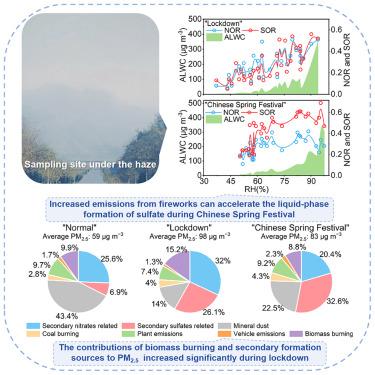西北城市减排背景区冬季PM2.5化学特征
IF 4.1
2区 综合性期刊
Q1 MULTIDISCIPLINARY SCIENCES
引用次数: 0
摘要
为研究城市减排对PM2.5污染特征的影响,在关中平原某特大城市附近开展了3个阶段的实地观测:新冠肺炎封城(“封城”)、封城前(“正常”)和封城后(“节日”)。观察结果显示,在“封城”期间,尽管二氧化氮和二氧化硫减少,但PM2.5显著增加。分子特征和PMF源分析表明,生物质燃烧对PM2.5的贡献比“正常”增加了70%以上。与此同时,在“封城”期间,二次气溶胶的形成(主要是通过液相氧化)占PM2.5水平的50%以上。此外,烟花燃烧释放的金属离子加速了硫酸盐的液相形成,导致二次硫酸盐相关来源在“节日”期间贡献了约33%的PM2.5。研究表明,生物质/烟花燃烧与液相氧化之间存在协同效应,表明不平衡的减排可能通过大气老化和区域运输加剧污染。有效的空气质量管理需要多种污染物的协调控制策略。本文章由计算机程序翻译,如有差异,请以英文原文为准。

Chemical characteristics of wintertime PM2.5 in background region of northwest China during urban emission reduction
To investigate the impact of urban emission reduction on particulate matter (PM2.5) pollution characteristics, field observations were conducted near a megacity in the Guanzhong Plain, China, during three periods: COVID-19 lockdown (“lockdown”), pre-lockdown (“normal”), and post-lockdown (“festival”). The observation showed that despite reduced NO2 and SO2, PM2.5 increased significantly during “lockdown.” Molecular characteristics and PMF source apportionment revealed that biomass burning contributions to PM2.5 increased by over 70% compared with “normal.” Meanwhile, secondary aerosol formation (primarily through liquid-phase oxidation) accounted for more than 50% of PM2.5 levels during “lockdown.” Additionally, metal ions released by fireworks burning accelerated the liquid-phase formation of sulfate, resulting in secondary sulfate-related sources contributing about 33% of PM2.5 during “festival.” The study demonstrates synergistic effects between biomass/fireworks burning and liquid-phase oxidation, indicating that unbalanced emission reductions may exacerbate pollution through atmospheric aging and regional transport. Effective air quality management requires coordinated multi-pollutant control strategies.
求助全文
通过发布文献求助,成功后即可免费获取论文全文。
去求助
来源期刊

iScience
Multidisciplinary-Multidisciplinary
CiteScore
7.20
自引率
1.70%
发文量
1972
审稿时长
6 weeks
期刊介绍:
Science has many big remaining questions. To address them, we will need to work collaboratively and across disciplines. The goal of iScience is to help fuel that type of interdisciplinary thinking. iScience is a new open-access journal from Cell Press that provides a platform for original research in the life, physical, and earth sciences. The primary criterion for publication in iScience is a significant contribution to a relevant field combined with robust results and underlying methodology. The advances appearing in iScience include both fundamental and applied investigations across this interdisciplinary range of topic areas. To support transparency in scientific investigation, we are happy to consider replication studies and papers that describe negative results.
We know you want your work to be published quickly and to be widely visible within your community and beyond. With the strong international reputation of Cell Press behind it, publication in iScience will help your work garner the attention and recognition it merits. Like all Cell Press journals, iScience prioritizes rapid publication. Our editorial team pays special attention to high-quality author service and to efficient, clear-cut decisions based on the information available within the manuscript. iScience taps into the expertise across Cell Press journals and selected partners to inform our editorial decisions and help publish your science in a timely and seamless way.
 求助内容:
求助内容: 应助结果提醒方式:
应助结果提醒方式:


